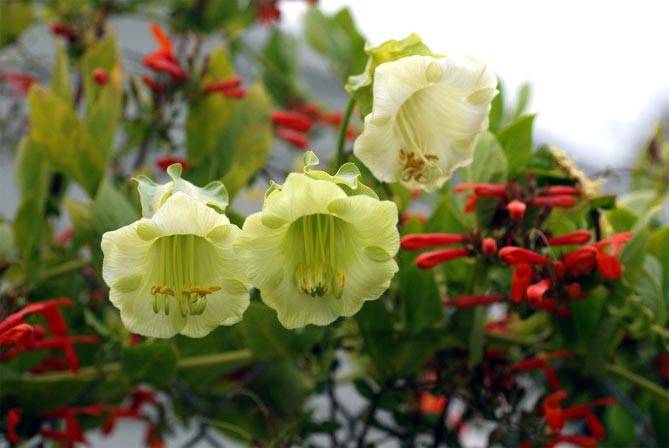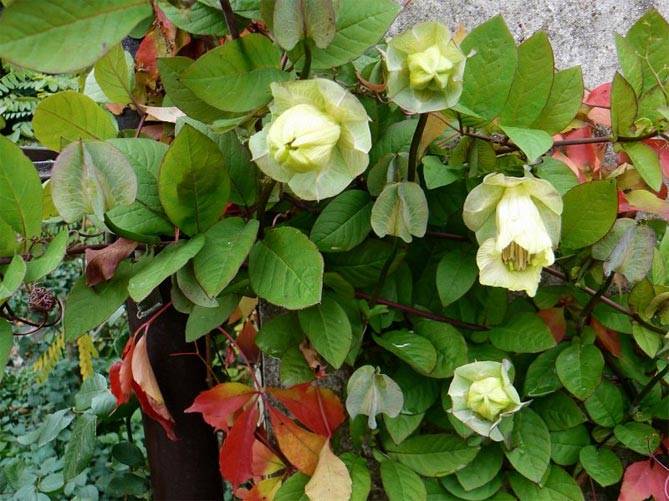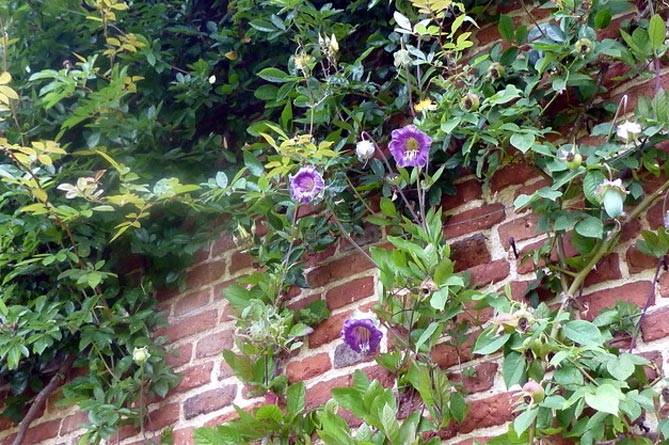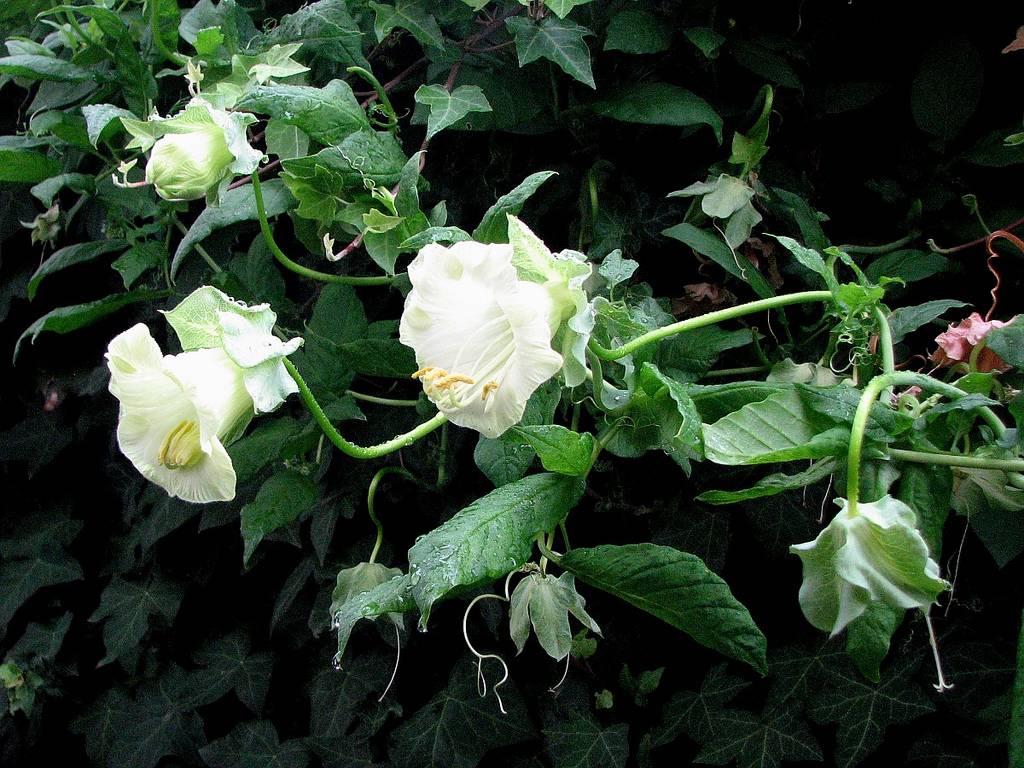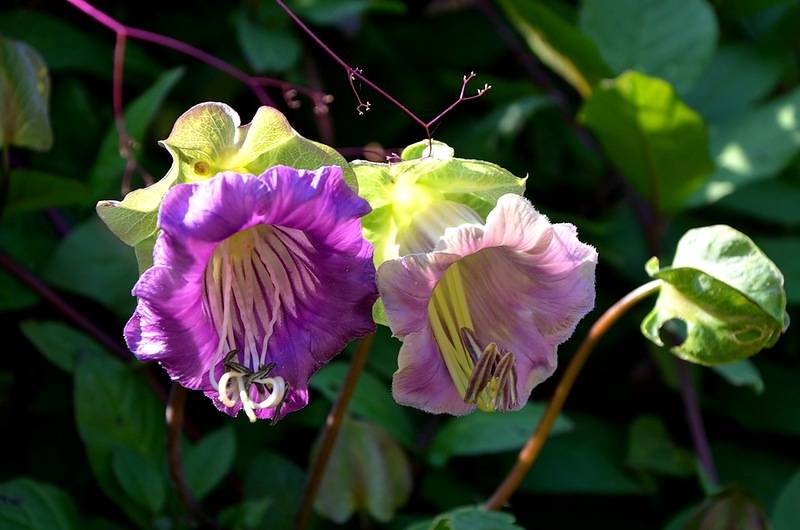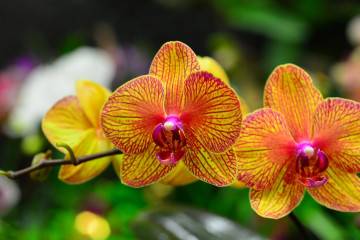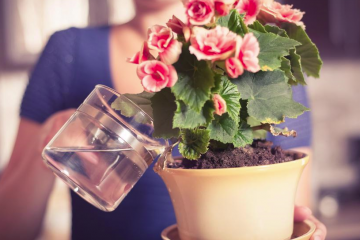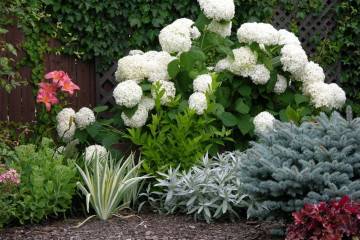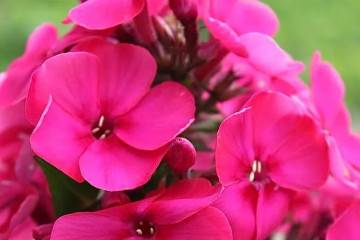Kobey climbing: what is it like, how to feed it to bloom
Content:
This plant grows wild in tropical or subtropical climates. It is a climbing liana that is well suited for use in vertical landscaping. With careful care, it will delight even the most picky gardeners with its flowering and aroma.
Features of the kobei climbing
When talking about a kobei flower, you need to know what it is. Native to South and Central America, this plant is widely used in landscaping. It has been cultivated for several centuries.
Briefly about the history of appearance
Under natural conditions, this plant grows in Mexico and Peru, where the length of its shoots can reach 25 m. It was named after the naturalist monk Kobo. The plant has been cultivated since 1787.
Plant characteristics
Kobei shoots grow up to 4 m. Flowers are similar in shape to bells. The buds are purple, white or pink. Flowers grow on long stems. Their diameter can be up to 7 cm.
Varieties that are in great demand among gardeners
Kobei is widely used in the field of landscape design. This plant has few varieties. The most popular ones are described below.
Alba
White flowers are a distinctive feature of this variety. Another is a subtle pleasant aroma. The bushes are up to 4 m long and twist well.
The Tsar Bell
This species of kobei plant grows up to 3 m in height. Kobea Tsar Bell is a climbing liana. Large flowers are white.
Cathedral bells
Flowers are slightly larger than other Cobaea varieties. They can reach a diameter of 8 cm. The buds are purple from the beginning to the end of flowering.
Colando
Kobei Kolando flowers have a deep blue-violet color. This variety is often used to decorate vertical surfaces. Flowers have very long stamens. This plant is very thermophilic.
Amazon
Kobea Amazon is capable of blooming with light green flowers. As they grow, they acquire a rich purple hue. Plant height is 4 m. It is capable of producing a large number of shoots.
Kobei from seeds: growing and transplanting seedlings into the ground
Growing seedlings increases the germination of the plant. However, it should be borne in mind that this procedure is lengthy and takes several months.Therefore, you need to start it as early as possible. Below is how a kobe is grown, planting and care in the open field.
Time to board
Since seeds ripen very slowly, they should be planted as early as possible. This is usually done in late February or early March.
Choice of capacity
You will need to soak a paper or gauze napkin in a growth stimulant solution. It should be slightly damp. The seed is carefully laid out on the surface of the napkin. Care must be taken not to touch neighboring seeds. Cover with a plastic bag on top and put on a saucer, which should be placed in a warm place.
Soil and seed preparation
It is necessary to maintain the humidity of the napkin. Also, the seeds must be regularly washed in a weak manganese solution. This is to prevent the formation of mold. After the procedure, the seeds are placed on a new napkin, which is also moistened in a stimulating solution.
Seedling care
As a rule, after 2-3 weeks have passed, sprouts will hatch from the seeds. When there are 2-3 leaves on them, each will need a separate pot. It is recommended to take those with a diameter of 9-11 cm.
Dive
For cultivation, a universal potting soil mixture can be used. It is poured into a pot and watered well. For planting seedlings, a deepening of 1.7 cm is enough. The seed with the sprout is placed in the ground with the flat part down.
For the growth of seedlings, it is necessary to provide a temperature of 15-18 ° C. The conditions in which the seedlings germinate depend on how much the kobe will stretch upward. The lower the temperature, the less this will be expressed.
Landing in open ground
Landing in a permanent place in open ground is as follows. Before that, for two weeks, the sprouts are taken out on the veranda every day. This is necessary for hardening the kobei. This is only allowed if the temperature is above 0 ° C.
For seedlings, it is necessary to prepare holes in which the root system will fit freely. A mixture of turf, peat and sand is poured onto the bottom. The wells are pre-watered. The earth is fertilized with double superphosphate.
To plant, the seedling is taken along with a lump of earth and transferred to a prepared hole and sprinkled with soil. The earth needs to be slightly compacted. Then you need to mulch using cut grass or sawdust.
How to grow from cuttings
To propagate kobei, cuttings are used. To get them, kobei shoots are cut in October-November, leaving no more than 30-40 cm. The bush in a spacious pot is transferred to a cool dry room. It is necessary to ensure that the temperature in it does not exceed 10 ° C.
When spring comes, cuttings are cut from the shoots. For germination, they are placed in a glass filled with water with the addition of a growth stimulant. The container is placed on the windowsill and waited until the roots are formed.
After that, pots 9 cm wide are filled with soil and cuttings are transplanted there. The first three days they are kept in the shade, then exposed to sunlight.
Features of care in the garden
After planting, pegs are installed to which this perennial plant will be tied.This is necessary so that it does not spread over the surface of the earth, but grows upward. Shoots that are too long must be pruned to ensure the lush growth of this vine.
This plant grows in the wild in the tropics. This is probably why kobei prefers to grow in warm conditions and in the absence of drafts. This vine loves fertile soil.
Kobei flower does not tolerate shading well. In these conditions, it will not die, but it will bloom worse. Waterlogging is also dangerous for him, which can lead to rotting of the roots.
Watering
The plant loves to receive a large amount of moisture. It is necessary to ensure that the top layer of the soil does not dry out, but there is no stagnation of moisture in the root system. If this happens, the roots will start to rot.
On hot days, you need to take additional care of the vine - spray the leaves.
Mulching
Mulching can be done using grass cuttings, compost or sawdust. This will keep moisture in the ground longer after watering.
Loosening
When growing kobei, it is necessary to regularly loosen the soil. It is especially important to do this after watering so that a crust does not form on the surface.
Top dressing
After planting, fertilizers are applied for the first time after two weeks. It is necessary that the fertilizing is nitrogen-containing. Potash fertilizers are what you can feed the kobei with during the bud growth period. However, they should not contain too much nitrogen.
Pruning
In the process of growth, purple kobei carry out pruning of long shoots. This is necessary so that the plant does not spread over the surface of the soil.
Preparing for winter
To prepare for the winter period when growing a climbing kobe, you need to do the following:
- Trim off all the stems of the plant.
- Transplant the bush into a flowerpot and place on the veranda.
- Ensure the temperature does not exceed 10 ° C.
- Watering is carried out every 20 days.
When and how it blooms
Beautiful large flowers grow on this vine. When a kobea blooms, you can admire its beauty for many months.
Types of flowers
Flowers can be single or inflorescences. Newly appeared buds are green-yellow in color. Then they gradually take on a purple or white color.
Flower shapes
Kobei flowers are shaped like bells. Their diameter is 7 cm. Long pedicels grow from the axils of the leaves.
Flowering period
The period when the kobei blooms is long. It starts in mid-summer and lasts until the first frost.
Changes in care during flowering
Flowering will be especially effective if you pay attention to the following:
- flowers that have already faded must be removed so that the plant does not waste its vitality on them;
- long stems are recommended to pinch;
- new shoots are required to be attached to the support soon after their formation.
In order for the flowers in the garden to show a rich color, steps must be taken to reduce the acidity of the soil.
Possible growing problems
Deviating from the rules of cultivation increases the risk of disease or pest infestation. In this case, you need to know what to expect and how to protect the plant.
Pests
Aphids and spider mites are dangerous. To combat them, you need to regularly inspect the plant. If pests are found, it is necessary to spray with special preparations. In particular, you can use flea shampoo or potash soap.
Diseases
The greatest danger to kobei is root rot disease. This is often caused by excessive watering, which causes stagnant moisture in the roots. A symptom of the disease is the appearance of dark spots on the foliage.
For prevention, it is important to regularly loosen the soil and control its moisture level. The affected plant parts must be removed and burned. At the same time, rotten roots and branches are cut off.
Signs of improper care
If the requirements for caring for the plant have been violated, then this can lead to the fact that the flowers are formed less than usual, or their color will be paler. With insufficient watering, the climbing kobe may begin to dry. Excessive moisture can cause root rot.
Growing kobei requires certain care rules. If you follow them, you can enjoy the luxurious flowering of this vine throughout most of the summer and autumn.

